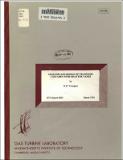Analysis and design of transonic cascades with splitter vanes
Author(s)
Youngren, H. H. (Harold Hayes)
Download23741877.pdf (7.048Mb)
Other Contributors
Massachusetts Institute of Technology. Gas Turbine Laboratory
Metadata
Show full item recordAbstract
A new computational method, MISES, is developed for turbomachinery design and analysis applications. The method is based on the fully coupled viscous /inviscid method, ISES, and is applicable to blade-to-blade analysis of axial fan and compressor stator or rotors with optional splitter vanes. Quasi-three dimensional effects for stream surface radius, streamtube thickness and wheel rotation may be included. The flow is modeled with the steady Euler equations and the integral boundary layer equations. A robust Newton-Raphson method is used to solve the coupled non-linear system of equations, requiring only several minutes for solution on a typical workstation. Design options are implemented for either single surface or camber redesign. The method is exercised by comparison with transonic cascade tests to validate the quasi-three-dimensional formulation. The results show excellent correlation to measured pressure distributions and loss levels. The multiple blade capability is demonstrated by comparison to test data for a supersonic cascade with splitter vane. New splitter vane configurations for improving the performance of the supersonic cascade are explored, resulting in large increases in turning and reduced loss.
Description
Includes bibliographical references (pages 162-164)
Date issued
1991Publisher
Cambridge, Mass. : Gas Turbine Laboratory, Massachusetts Institute of Technology, 1991
Series/Report no.
GTL report #203